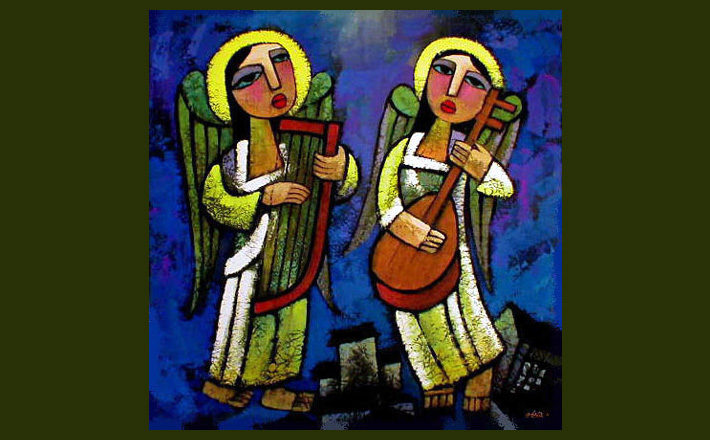Commentary on Luke 7:1-10
There is a question that runs throughout the “orderly account” so carefully and thoughtfully prepared for “most excellent Theophilus” (Luke 1:3).
And that question is, “Who then is this?” (Luke 8:25). It is the question asked by shepherds out in a field, “Let us go now to Bethlehem and see this thing” (Luke 2:15). It is the question asked by a gathering in a synagogue in Nazareth, “Is not this Joseph’s son?” (Luke 4:22). It is asked by the followers of John, “Are you the one who is to come, or are we to wait for another?” (Luke 7:18) Who is this man born in Bethlehem, this teacher, this preacher? How is one to make sense of, to trust what he says and understand what he does?
I have a good friend who often reads mysteries backwards. As she began to read the book she would go to the end and find out “who-did-it.” She could then relax and enjoy the book as it unfolded knowing already how it would turn out. In a way, that is how we read Luke-Acts. We already know the ending of the story. We know that this man will travel through the land teaching and healing. We know that he will be suffer and die on the cross, but that on the third day he will be raised. We know that he will be “carried up into heaven.” (Luke 24:51) Like the disciples we can worship with great joy because we know that this is a story with a happy ending. We know who he is. We know the answer to the question.
What if we were to try to read this orderly account as if we did not know the end of the story? What if we did try to answer the question afresh, “who then is this?” Do we really know who Jesus is?
The season of Easter and Pentecost has come and gone and the church now moves into Ordinary Time. Over the next few weeks we are going to be reading through an amazing group of stories. They are stories of healings of various kinds, including resuscitation. They provide the church and the preacher with an opportunity for a sermon series exploring this question, “Who then is this?” As R. Alan Culpepper notes in his examination of Luke in the New Interpreter’s Bible, these stories explore the proclamation that Jesus is the “Messiah greater than a prophet.”1
The writer of Luke-Acts is much like a reporter in that in each of these stories he explores the traditional questions of who-what-when-where-how. I would argue that it is up to you, the preacher, to explore the “why.” The first story is a story of a healing. But as we shall see in each of the stories over the following weeks, each story has its particular shape and particular theme.
The reading tells us the when — “Jesus had finished all his sayings.” (Luke 7:1) Those sayings would be the “Sermon on the Plain;” the Beatitudes. Jesus had been telling a great crowd what it looks like to be a disciple. He has told them it means to love friend and enemy alike. We are told the where — Jesus finds himself back home in Capernaum. There he is met by a group of the elders from the synagogue. They ask him to heal the slave of a centurion posted in the town. It would seem that Jesus is being asked to practice what he preached.
There are many “who’s” in this story: Jesus, the elders, the centurion (whom we never meet directly), the friends of the centurion, and the sick slave (also whom we never meet). Might we think of the centurion, a gentile, and a representative of the empire that is oppressing the nation, as an enemy?
After the important who, the gentile centurion, perhaps the what and the how are the most intriguing elements in this story. The centurion does not presume to come to Jesus himself. One might wonder if he would not be surprised if Jesus were to refuse to speak to him. Would Jesus want to be seen speaking to a Roman soldier? What would it do to Jesus’ reputation? There are several elements of the what. First, many important members of the community are willing to speak to Jesus on behalf of an outsider. He may not be a Jew, but he should be considered a friend of the Jews as he paid for their synagogue. We also learn more about the centurion from the fact that he is willing to reach out to the rabbi on behalf of his slave. He cares enough about this person to seek Jesus help. (Could it be that his slave is a Jew?) The centurion has heard about and honors the power of this teacher and healer. He also respects Jesus enough to send another delegation to tell Jesus that he does not have to come to the house. We need to remember that Jesus, a rabbi, would be rendered unclean if he were to go into the home of a gentile. The centurion is aware of Jesus’ power. He knows that Jesus only has to “speak the word, and let my servant be healed” (Luke 7:7).
That is the what of this story. Jesus does speak the word. He does not go to the centurion’s home. He does not touch the slave. The amazing element of this story if that Jesus is the one who is amazed — not the centurion, not the various groups that go to speak with Jesus, but Jesus himself. Jesus is astounded at the faith of this “enemy”, this gentile. This man’s faith engenders a “long-distance” healing.
This is a story about identity and authority. The centurion recognized who Jesus was — did the elders and residents of Capernaum? Jesus does love his enemy. Jesus heals the slave of the centurion because of his owner’s faith. Are we willing to approach Jesus, for ourselves, for our friends, for our enemies? How does this story help us begin to answer the question, “who then is this?”
Notes:
1 R. Alan Culpepper, “Luke” in The New Interpreter’s Bible, Volume IX. Nashville, TN: Abingdon Press, 1995, 153.


May 29, 2016